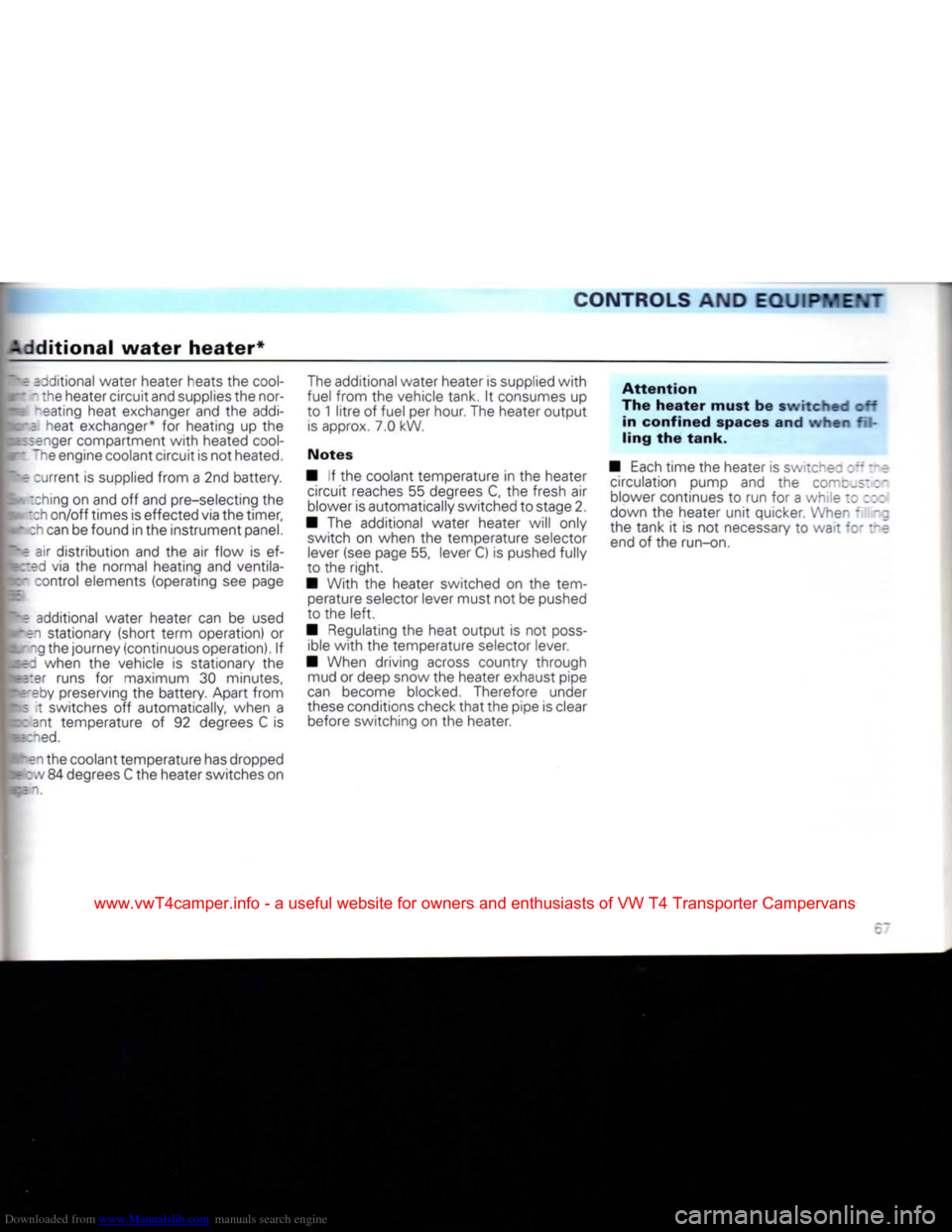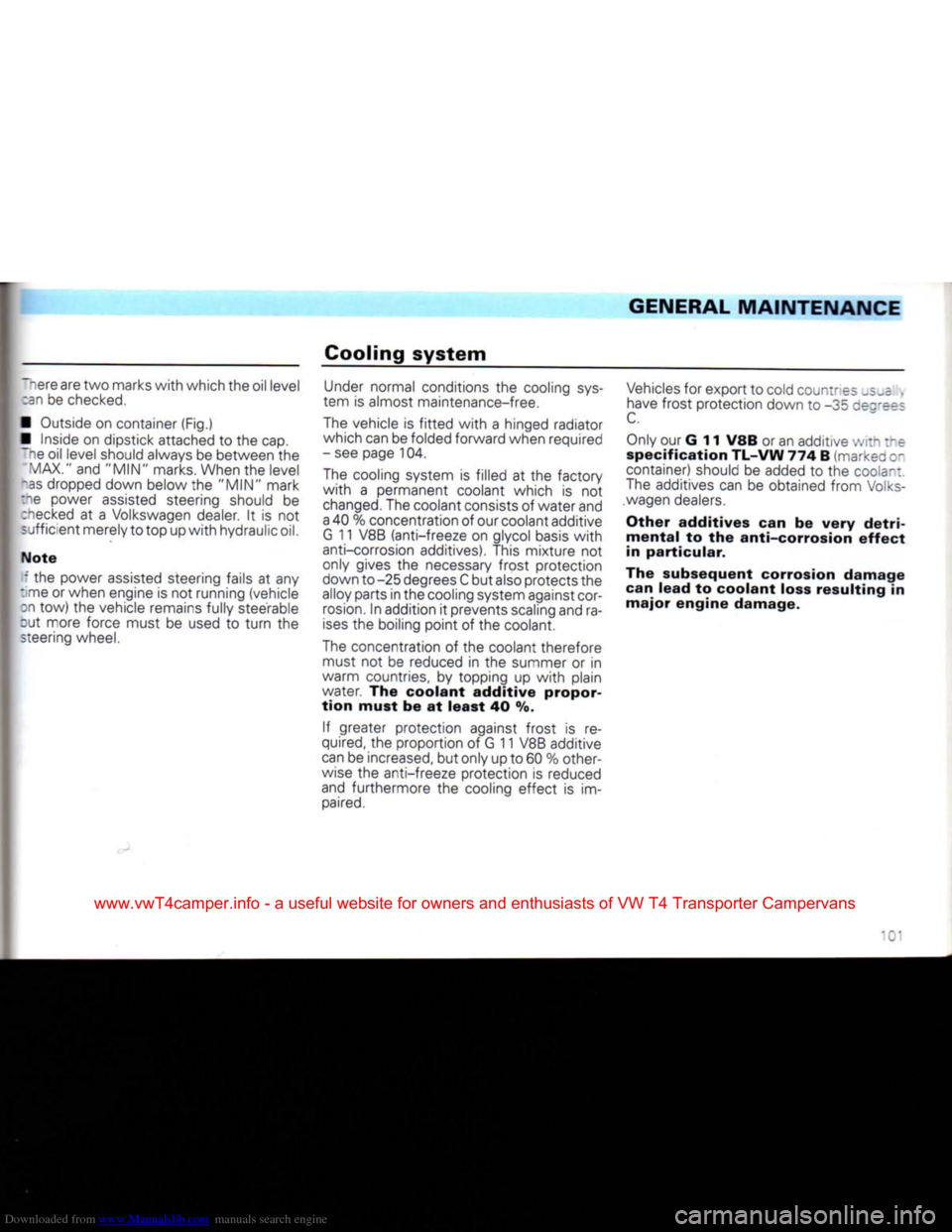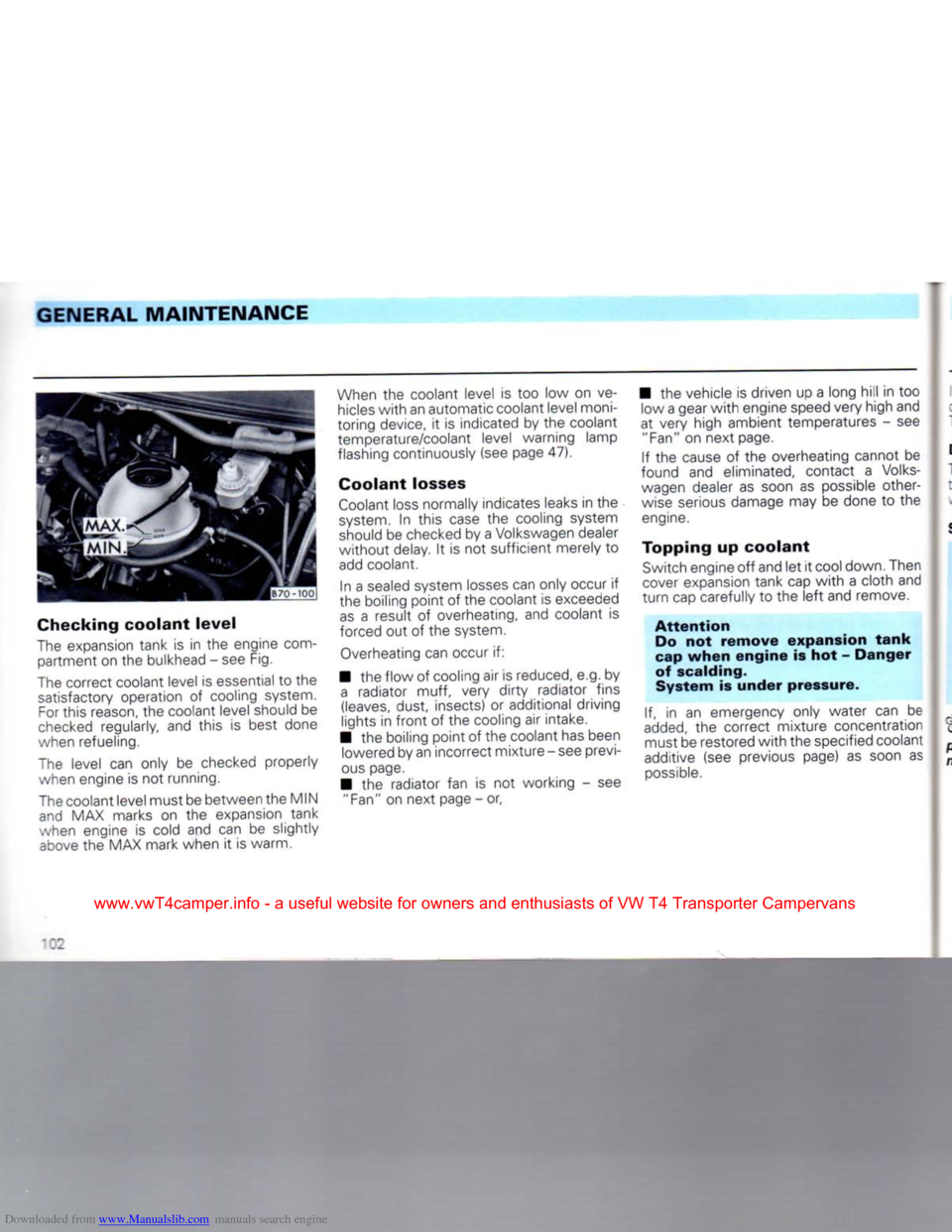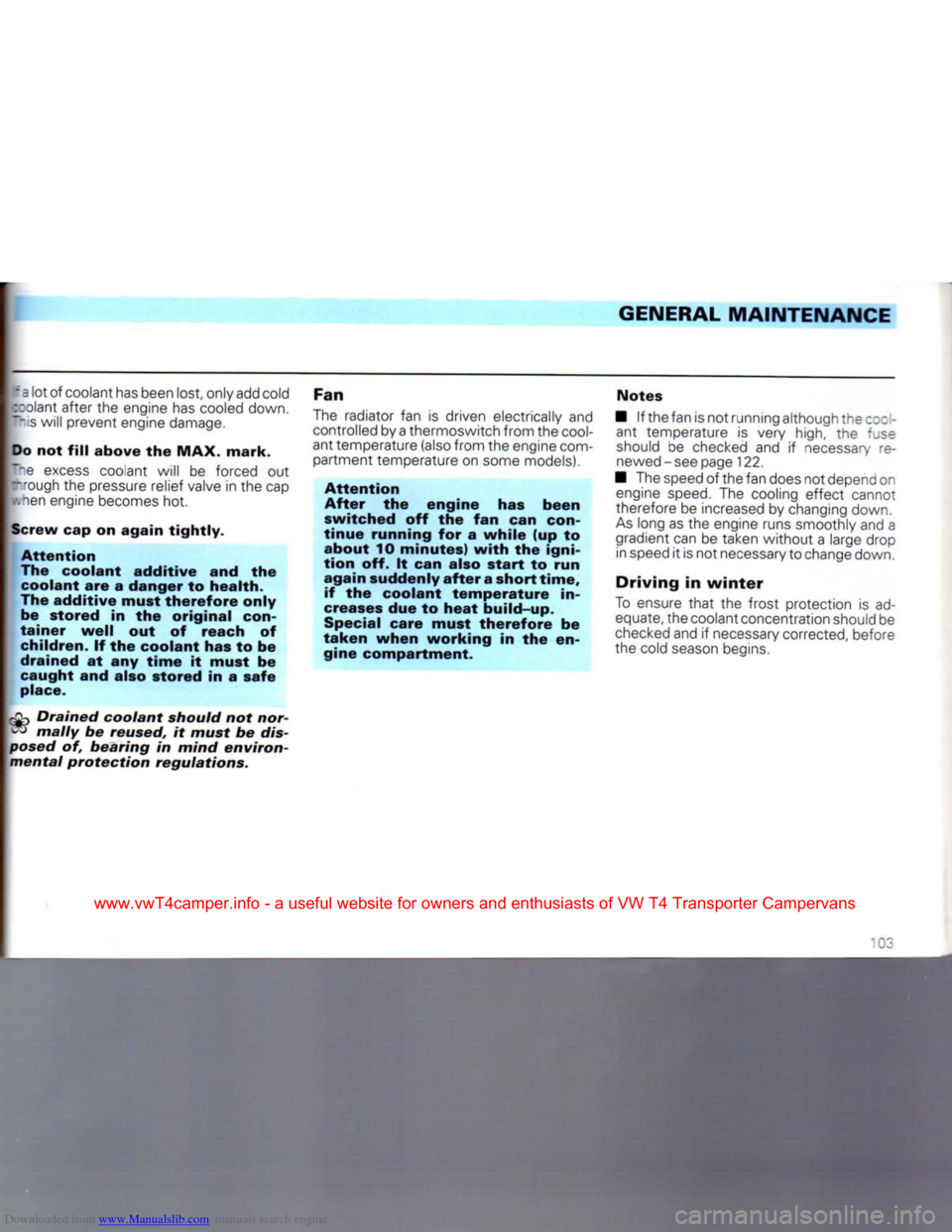1992 VOLKSWAGEN TRANSPORTER coolant
[x] Cancel search: coolantPage 62 of 164

Downloaded from www.Manualslib.com manuals search engine
CONTROLS
AND
EQUIPMENT
Notes
Pools of
water
under
the
vehicle
• When the ambient temperature is high
and
the air very humid, condensed water
can
drip off the evaporator and form a puddle under the vehicle. This is quite nor
mal
and does not indicate a leak.
Operating
faults
• Should the air conditioner not work at
any
time, either:
- the ambient temperature is below about + 5 degrees C,
- the fuse has blown.
Check
fuse and if necessary renew it - see
page
122. If the trouble is not due to
a
defec
tive fuse, switch the system off and have it
checked.
- the air conditioner has switched off due to the coolant temperature being too high -
see
page 41
also.
• If the cooling
output
drops off, switch the
A/C
off and have the system
checked.
Using air
conditioner
economically
In cooling operation the air conditioner
com
pressor
places demands on the engine and
therefore influences the fuel consumption.
To
keep the period switched on as short as
possible,
the following points should be
noted:
• If the inside temperature is very high after the vehicle has been parked in the sun, it is recommended to open doors or win
dows
briefly to enable the hot air to
escape.
• The air conditioner should not be
switched
on during a journey if the windows
or
sliding/tilting
roof*
are open.
• If the desired interior temperature can be attained
without
switching on the air condi
tioner, the fresh air operation should be se
lected.
Recirculating
air
switch
If badly contaminated air is to be prevented
from entering the vehicle, e.g. when driving
through a tunnel, the recirculating air switch in the instrument panel can be
pressed.
When
the recirculating air system is
switched
on, a small warning lamp lights up in the switch.
However,
the recirculating air system
should
only be used for a short period other
wise
the windows will mist up.
60
www.vwT4camper.info - a useful website for owners and enthusiasts of VW T4 Transporter Campervans
Page 69 of 164

Downloaded from www.Manualslib.com manuals search engine
CONTROLS
AND
EQUIPVE\
Additional
water
heater*
E
additional water heater heats the
cool-
— ;he heater circuit and supplies the nor- • ^eating heat exchanger and the addi-
:~a
heat exchanger* for heating up the
rsaenger
compartment
with
heated
cool-
' ""e engine coolant circuit is not heated.
I current is supplied from a 2nd battery.
:ching
on and off and pre-selecting the
. :ch on/off times is effected via the timer,
- :h can be found in the instrument panel.
~a
air distribution and the air flow is ef-
:::ed
via the normal heating and ventila- : li aontrol elements (operating see page
a
additional water heater can be used
•en
stationary (short term operation) or -g the journey (continuous operation). If
.a;
when the vehicle is stationary the
•Her
runs for maximum 30 minutes,
;eoy
preserving the battery. Apart from
• 5 t switches off automatically, when a .: ant temperature of 92 degrees C is
Bcned.
"
an
the coolant temperature has dropped
-: .v 84 degrees C the heater switches on
The
additional water heater is supplied
with
fuel from the vehicle tank. It consumes up
to
1
litre
of fuel per hour. The heater output
is
approx. 7.0 kW.
Notes
• If the coolant temperature in the heater circuit reaches 55 degrees C, the fresh air
blower is automatically switched to stage 2.
• The additional water heater will only switch on when the temperature selector
lever
(see page 55, lever C) is pushed fully
to the
right.
• With the heater switched on the tem perature selector lever must not be pushed
to the
left.
• Regulating the heat output is not
poss
ible
with
the temperature selector lever.
• When driving across country through mud or deep snow the heater exhaust pipe
can
become blocked. Therefore under
these
conditions check
that
the pipe is clear before switching on the heater.
Attention
The
heater
must
be s . ::'-
a
: : in confined spaces and when fil
ling
the
tank.
•
Each
time the heater is sw :ce:
circu
at .-' pump and the comes::-blower continues to run for a v. K.e :: :::
down the heater
unit
quicker. Wher,-:. rg
the tank it is not necessary to vva :
end
of the run-on.
www.vwT4camper.info - a useful website for owners and enthusiasts of VW T4 Transporter Campervans
Page 85 of 164

Downloaded from www.Manualslib.com manuals search engine
DRIVING
TIPS
• Where possible make
full
use of the maximum permissible drawbar weight on
call
of the towing bracket - see page 151 -
cut do not exceed it.
• While observing the permissible trailer
and
drawbar weight, distribute the load in
the trailer so
that
heavy objects are as near
as
possible to the axle. The objects must
a
so be secured so
that
they cannot slip
aoout.
• Check the
tyre
pressures on the towing
/ehicle
and the trailer.
• The headlight settings, should be
:hecked
with
trailer attached before mov- ng off and adjusted as necessary.
On
vehicles
with
headlight beam control it
is
only necessary to
turn
the knurled disc in
:ash
in the appropriate direction.
Driving
instructions
To
obtain the best possible handling of ve
hicle
and trailer, the following should be
noted:
• Try to avoid driving
with
an unladen ve
hicle
and a loaded trailer. If this cannot be
avoided,
only drive slowly to allow for the unfavourable weight distribution.
• As driving stability of vehicle and trailer
decreases
when the speed increases do not
drive at the maximum permissible top
speed
in unfavourable road, weather or
wind conditions - particularly when going downhill. In any
case
the speed must be reduced im
mediately the trailer shows the slightest
sign
of snaking. On no account try to stop
the snaking by accelerating.
• For safety reasons one should not drive faster than 80 km/h (50 mph). This also
applies
in countries where higher speeds
are permitted. • Always brake in good time. If the trailer
has
an overrun brake, apply the brakes gen
tly at
first
then firmly. This will avoid the
jerk
ing caused by the trailer wheels locking.
Change
down before going down a steep hill so
that
the engine can act as a brake.
• When a long climb in a low gear
with
ex tremely high engine revs must be nego
tiated at exceptionally high ambient temperatures the coolant temperature gauge must be observed. When the gauge needle
moves
to the
>~zza'
e~z of :ne
scale,
the road speed must be reduced immediately. If nevertheless ~g amp flashes,
stop immediately and si ow the engine to
cool
off at idling speed for several minutes.
• The cooling effect of the radiator fan
can
not be increased by changing down, be
cause
the speec of t~e
~a~
s ~o! dependent
on the engine
speed.
One should therefore not change down even when towing a
trailer as long as :-e e-g -e zar cope with out the vehicle speed dropping too much.
83
www.vwT4camper.info - a useful website for owners and enthusiasts of VW T4 Transporter Campervans
Page 95 of 164

Downloaded from www.Manualslib.com manuals search engine
GENERAL
MAINTENANCE
Maintenance
-s
the
vehicle
is
fitted
with
modern
low
~aintenance
technical components only
small
amount
of
regular servicing
is re
tired
in
order
to
maintain
the
roadworthi-
"sss,
economy and reliability.
~ne Inspection Service offered by the Vol ks-
I
agen dealers takes into account
to a
large
extent
the
individual annual mileage
cov-
e-ed and helps thus
to
keep
the
operating
:osts
as
low as possible.
Regular maintenance helps to
-J
ensure
that
the emissions - and
thus the environmental burden are
kept
as low as possible.
The
Inspection
Service
is
required
every
12
months
or
every
30 000 km,
. nichever occurs
first.
I
a mileage
of
15 000
km
(petrol engines)
or
"500
km
(Diesel engines)
is
reached before "2 months
has
elapsed,
the Oil
change
Service must
be
carried out. See page
98
5
so and
the
Service Schedule.
~ie Service Schedule also shows what »rk
is
done
at the
Inspection
and Oil
Inange
Services.
In
arduous
operating
conditions, e.g.
extremely low ambient temperatures, very
dusty conditions etc. certain service oper
ations should be carried
out
between the in
tervals specified.
This
applies
in
particular
to:
• Changing
the
engine
oil
• Cleaning
or
changing
the air
cleaner
el
ement
• Draining water from
or
renewing the fuel
filter
on the
Diesel engine
The
service operations should be carried out by
a
Volkswagen dealer because this work
requires specialist knowledge, workshop
equipment and special tools. Furthermore
this work must
be
done
in
accordance
with
out instructions.
Complete
proof
of
servicing
by a
Volks
wagen dealer can be one
of
the stipulations
for
the
upholding
of any
warranty claims during
the
one year warranty period.
Attention
Safety
regulations
place
very
strict
limits
on the
amount
of re
pairs
and
adjustments
to
engine
and
running
gear
parts
which
can
be
done
by the
owner.
By
tinker
ing
with
parts
which affect
the
safety
of a
motor
vehicle
one can
endanger
oneself
and
other road users.
Altering the engine settings is detrimental to the
exhaust
emissions.
This means
that
the envi
ronment is burdened unnecessarily
and the
fuel
consumption
also
in
creases.
The disposal of old oil, used brake
fluid,
dirty
coolant, defective
bat
teries or worn-out tyres etc. must be
done according to environmental
protection regulations. It is even
better
if old operating fluids and parts are used
again
and
do not become a burden on the envi
ronment. Through "recycling" valu
able
raw-materials and
energy
are
saved and at the same
time
it re lieves the load on the toxic waste
dumps.
Volkswagen dealers collect
all reusable materials and parts and
passes
them
on to the correct
agency
for recycling.
www.vwT4camper.info - a useful website for owners and enthusiasts of VW T4 Transporter Campervans
Page 97 of 164

Downloaded from www.Manualslib.com manuals search engine
GENERAL
MAINTENANCE
Engine
compartment
Page
Windscreen
washer
container
.. 108
Power
assisted
steering
fluid
reservoir*
100
Engine
oil filler
opening
97
Engine
oil
dipstick
97
Coolant
expansion
tank 102
Brake
fluid
reservoir
104
Battery
106 Attention
Particular care should be
taken
when working in the engine
com
partment!
•
Switch off engine, remove ignition key.
•
Pull handbrake on firmly.
•
Move gear lever into neutral or
"P"
position.
•
Allow engine to cool off.
•
As long as the engine is at op
erating temperature:
-
Do not put your hand into the radiator fan, it could switch on
suddenly.
-
Do not open the radiator cap be
cause
the cooling system is
under
pressure.
•
Avoid causing short circuits in
the electrical system - particular ly at the
battery
-.
•
If tests have to be
carried
out
with
the engine running,
there
is
an additional danger
present
from rotating parts - e.g.
V-belts,
generator, radiator fan etc. - and
from the high voltage ignition
system.
Attention must be paid to the warnings given in this Instruc
tion Manual and to the generally
applicable
safety regulations.
When topping up fluids one
should
ensure
that
they are not mistaken,
one
for the other, under any
circum
stances,
otherwise serious
func
tional defects
will
result.
So
that
leaks
are quickly de
tected
the ground underneath
the vehicle should be checked
reg
ularly.
If spots as caused by oil or
other
operating fluids can be seen, the vehicle should be
taken
to the
workshop for checking.
www.vwT4camper.info - a useful website for owners and enthusiasts of VW T4 Transporter Campervans
Page 103 of 164

Downloaded from www.Manualslib.com manuals search engine
GENERAL
MAINTENANCE
nere are two marks
with
which the oil level
:an be
checked.
• Outside on container (Fig.) • Inside on dipstick attached to the cap. ~he oil level should always be between the
MAX."
and "MIN" marks. When the level
"as
dropped down below the "MIN" mark
:^e
power assisted steering should be
:necked
at a Volkswagen dealer. It is not
sufficient merely to top up
with
hydraulic oil.
Note
f the power assisted steering fails at any
: me or when engine is not running (vehicle on tow) the vehicle remains fully steerable cut more force must be used to
turn
the
steering wheel. Cooling
system
Under
normal conditions the cooling
sys
tem is almost maintenance-free.
The vehicle is
fitted
with
a hinged radiator
which can be folded forward when required
- see page 104.
The cooling system is filled at the factory
with
a permanent coolant which is not
changed.
The coolant consists of water and
a
40 % concentration of our coolant additive
G
11 V8B (anti-freeze on glycol basis
with
anti-corrosion additives). This mixture not
only gives the necessary frost protection
down to -25 degrees C but also protects the
alloy parts in the cooling system against cor
rosion.
In addition it prevents scaling and ra
ises
the boiling point of the coolant.
The concentration of the coolant therefore must not be reduced in the summer or in
warm countries, by topping up
with
plain
water. The
coolant
additive
propor
tion
must
be at
least
40 %.
If greater protection against frost is re
quired, the proportion of G 11 V8B additive
can
be increased, but only up to 60 % other
wise the anti-freeze protection is reduced
and furthermore the cooling effect is im
paired.
Vehicles
for export to cold countries -s~a .
have frost protection down to -35 decrees
C.
Only
our G 11 V8B or an additive v/rs :~e
specification
TL-VW 774 B (markea or
container) should be added to the coolant.
The additives can be obtained from
Volks
wagen dealers.
Other
additives
can be
very
detri
mental
to the
anti-corrosion
effect
in
particular.
The
subsequent
corrosion
damage
can
lead
to
coolant
loss
resulting
in
major
engine
damage.
www.vwT4camper.info - a useful website for owners and enthusiasts of VW T4 Transporter Campervans
Page 104 of 164

Downloaded from www.Manualslib.com manuals search engine
GENERAL
MAINTENANCE
Checking
coolant
level
The
expansion tank
is in the
engine
com
partment on the bulkhead
-
see Fig.
The
correct coolant level
is
essential
to
the satisfactory operation
of
cooling system.
For
this reason, the coolant level should
be
checked
regularly,
and
this
is
best done
when refueling.
The
level
can
only
be
checked properly
when engine
is
not running.
The
coolant level must be between the MIN
and
MAX marks
on the
expansion tank
when engine
is
cold
and can be
slightly
above
the MAX mark when
it
is warm.
When
the
coolant level
is too low on ve
hicles
with
an automatic coolant level moni
toring device,
it is
indicated by the coolant
temperature/coolant level warning lamp
flashing continuously (see page 47).
Coolant
losses
Coolant
loss normally indicates leaks in the
system.
In
this
case
the
cooling system
should
be checked by a Volkswagen dealer
without
delay.
It is
not sufficient merely
to
add
coolant.
In
a
sealed system
losses
can only occur
if
the boiling point
of
the coolant is exceeded
as
a
result
of
overheating, and coolant
is
forced out
of
the system.
Overheating can occur
if:
• the flow
of
cooling air is reduced, e.g.
by
a
radiator
muff,
very
dirty
radiator fins
(leaves,
dust, insects)
or
additional driving
lights
in
front
of
the cooling air intake.
• the boiling point
of
the coolant has been lowered by an incorrect mixture
-
see previ
ous
page.
•
the
radiator
fan is not
working
- see
"Fan"
on next page
-
or, • the vehicle
is
driven up
a
long hill
in too
low a gear
with
engine speed very high and
at very high ambient temperatures
-
see
"Fan"
on
next page.
If
the
cause
of the
overheating cannot
be
found
and
eliminated, contact
a
Volks
wagen dealer
as
soon
as
possible other
wise
serious damage may
be
done
to the
engine.
Topping
up
coolant
Switch
engine
off
and let
it
cool down. Then
cover
expansion tank cap
with
a
cloth and
turn
cap carefully
to
the
left
and remove.
Attention
Do
not
remove
expansion
tank
cap
when
engine
is
hot
-
Danger
of scalding.
System
is
under
pressure.
If, in an
emergency only water
can be
added,
the
correct mixture concentration must be restored
with
the specified coolant
additive (see previous page)
as
soon
as
possible.
•02
www.vwT4camper.info - a useful website for owners and enthusiasts of VW T4 Transporter Campervans
Page 105 of 164

Downloaded from www.Manualslib.com manuals search engine
GENERAL
MAINTENANCE
"=
lot
of
coolant has been lost, only add cold
:_:olant after
the
engine has cooled down.
~~
is
will prevent engine damage.
Do
not
fill
above the MAX. mark.
~~e
excess
coolant will
be
forced
out
"rough
the
pressure relief valve
in the
cap .-.nen engine becomes
hot.
Screw
cap on again tightly. Attention
The coolant additive and the coolant are a danger to health.
The additive must therefore only be stored in the original
con
tainer
well
out of reach of
children.
If the coolant has to be
drained at any
time
it must be
caught and also stored in a safe
place.
Drained
coolant
should
not nor-
W*
mally
be
reused,
it
must
be
dis
posed
of,
bearing
in
mind
environ
mental
protection
regulations.
Fan
The radiator
fan is
driven electrically
and
controlled by a thermoswitch from the
cool
ant temperature (also from the engine
com
partment temperature on some models).
Attention
After the engine has been
switched off the fan can
con
tinue running for a
while
(up to
about 10 minutes)
with
the igni
tion off. It can also
start
to run
again suddenly
after
a short time, if the coolant temperature in
creases
due to
heat
build-up.
Special
care must therefore be
taken when working in the en gine compartment. Notes
•
If
the fan is not running although the
cool
ant temperature
is
very high,
the rse
should
be
checked
and if
necessary
re
newed
-
see page 122.
• The speed
of
the fan does not depeno
or
engine
speed.
The
cooling effect cannot
therefore
be
increased
by
changing down.
As
long as
the
engine runs smoothly and
a
gradient can
be
taken
without
a
large drop in speed
it
is not necessary to change down.
Driving in
winter
To
ensure
that
the
frost protection
is ad
equate, the coolant concentration should be
checked
and
if
necessary corrected, before
the cold
season
begins.
www.vwT4camper.info - a useful website for owners and enthusiasts of VW T4 Transporter Campervans